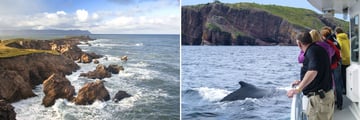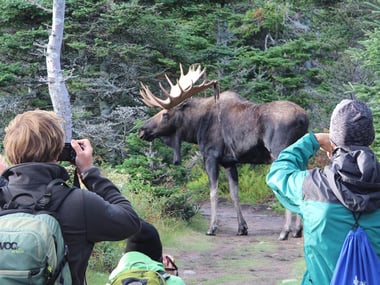Day 1
Fly to Halifax
Arrive in Halifax and check into Delta Hotel by Marriott Halifax (or similar). Enjoy strolling through this coastal city with a fascinating maritime history and if you have time the Maritime Museum of the Atlantic with its Titanic artefacts is worth a visit.
Day 2
Halifax – Lunenburg (60 miles)
Pick up your motorhome from the depot and drive the scenic costal route west of the city to the suggested campsite of Lunenburg. En-route stop at Peggy’s Cove, home to the country’s most photogenic lighthouse and also a launching point for short boat trips out to a nesting puffin colony and Seal Rock. The colourful, painted town of Lunenburg is a UNESCO world heritage site and the fisheries museum explains the importance of the town during the fisheries boom.
Day 3
Lunenburg – Kejimkujik National Park (72 miles)
Spend the morning enjoying a cruise from the harbour and see the pretty town from a completely different perspective. Sailing schooners are what the town is famous for and you can join a 2 hour cruise, you might even be able to sail on the famous Bluenose if it’s in its hometown. In the afternoon take a drive inland to the Kejimkujik National Park.
Day 4 and 5
Kejimkujik National Park – Digby (65 miles)
Enjoy the National Park, its wildlife and famous petroglyphs; you can walk, hike or canoe the trails and rivers. By late afternoon continue your journey heading towards Digby on the North West coast of Nova Scotia where we recommend staying at an oceanfront campsite for two nights so you have plenty of time for whale watching and exploring this stunning bay. In summer the bay provides a mating ground for Whales such as Humpback, Minke and Right Whales and one of the best places to enjoy them is from the quaint Brier Island. You will need to drive the length of the scenic peninsula where land is linked by two cable ferries to reach the island but it is worth the trip with friendly local restaurants, a beautiful beach, hiking trails and boat trips waiting for you.
Day 6 and 7
Digby – Fundy Trail National Park (128 miles)
Take the ferry over the Bay of Fundy into New Brunswick and head to the wonderful Fundy Trail Provincial Park. This is the name given to a particularly beautiful 30km stretch of coastline that has been developed so that you can enjoy the views and the natural wonders from the road via observation decks. But we highly recommend parking up and exploring the walking trails, the beaches and suspension footbridge.
At the end of the day head to the Fundy National Park, where a 2 night stay is recommended so you have a full day to explore the park; this is where you will find the highest tides in the world and over 25 waterfalls.
Day 8 and 9
Fundy National Park – Kouchibouguac National Park (134 miles)
Before driving north head to Hopewell Rocks to really explore those epic tidal movements (up to 48 ft twice a day!) at The Ocean Tidal Exploration Site. Check tide times and go at low tide so you can stand on the ocean floor or high tide if you prefer to kayak.
Stay two nights at Kouchibouguac National Park with a full day at leisure in the park, home to diverse ecosystems, with sand dunes, forests, tidal rivers and tall forests meeting here. As well, the park is proud of its designation as a Dark Sky Preserve, giving visitors a rare opportunity to witness the spectacular night sky without light pollution from urban areas, and if you visit at night you will see thousands of stars, constellations, and sometimes even the northern lights appear. Or you can take a lobster cruise on Shediac Bay – where a thrilling, educational and culinary experience awaits you participating in the actual fishing and catching of lobster, one of the most prized undersea crustaceans.
Day 10 and 11
Kouchibouguac National Park – Prince Edward Island (146 miles)
Crossing over the Confederation Bridge onto the island where we recommend 2 nights at Charlotte Town Campground. The island is famous for both its numerous Lighthouses and for being the setting of Anne of Green Gables so pack a copy of the book if you haven’t read it already.
Day 12
Prince Edward Island – Lake Ainslie (156 miles)
When you leave the island the ferry drops you at Pictou, where the first Scottish settlers landed; your afternoon drive east will take you to Cape Breton Island with an overnight stay at Lake Ainslie.
Day 13 and 14
Lake Ainslie – Cape Breton Highlands National Park (78 miles)
Your first stop is the coastal town of Inverness and a notable difference from its British namesake is the sea temperature. Known for warm ocean water and great for a dip, it also offers beachcombers some unique treasure as coloured sea glass washes up here (known as Mermaid’s tears).
After this worthy detour, keep going North to the Cabot Trail, one of Canada’s great scenic drives that goes from sea level to elevations of 3000 ft. The entire trail is a 185 mile loop overlooking the Gulf of St Lawrence on one side and the Atlantic on the other and traversing the northern points of the Cape’s National Park, where deep river valleys are home to moose, black bears, and bald eagles
Stay 2 nights at a campground in the National Park such as Cheticamp, nestled between river and mountains and with easy access to 26 hiking trails and a great base for exploring the area.
Day 15
Cape Breton Highlands National Park – Halifax (283 miles)
Your last day of driving covers a lot of ground as you follow the east coast of Nova Scotia all the way back to Halifax. Take a stop at Martinique beach for lunch and arrive at Halifax in the evening where your campground awaits.
Day 16
The depot for returning your motorhome is located at the campsite so spend a morning packing up and saying goodbye to your home on wheels, before heading to the airport.
















